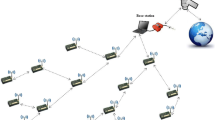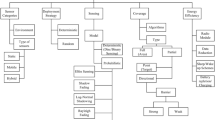Abstract
Retransmission is the most common data transmission mechanism in wireless sensor networks, and can improve data transmission reliability via the acknowledgement mechanism. However, the simple acknowledgement retransmission is associated with some negative factors such as data delay, low throughput among others. To overcome the shortcomings of the retransmission mechanism, redundancy coding is introduced to wireless communications, which has been widely applied in 4G communication. Unfortunately, not all redundant erasure codes are suitable for wireless sensor networks, as nodes’ energy, processing power, and storage capacity are all limited. Moreover, we also need to consider data transmission delay. Therefore, to improve data transmission reliability, we must take into account the complexity of algorithm, data transmission delay, node energy consumption, and other factors. In this article, we propose a REliable reSIDuE number system-based data transmission mechanism (RESIDENT) for WSNs, which can improve data transmission reliability via hybrid automatic repeat requests in hop-by-hop scenarios. In order to decrease the complexity of decoding, we present our algorithm and the proof of correctness, and report the performance using extensive set of simulation experiments. Our simulation results show that RESIDENT exhibits a good performance when compared to the previous studies, not only in terms of reliable data transmission, but also in end-to-end delay and energy consumption.









Similar content being viewed by others
References
Purohi, N., Varadwaj, P., & Tokekar, S. (2008). Reliablity analysis of wireless sensor network. In IEEE international conference on natural language (pp. 1–6).
Katiyar, M., Sinha, H. P., & Gupta, D. (2012). On reliability modeling in wireless sensor networks—a review. International Journal of Computer Science Issues, 9(3), 99–105.
Mahmood, M. A., Seah, W., et al. (2015). Reliability in wireless sensor networks: Survey and challenges ahead. Computer Networks, 79, 166–187.
Kim, S., Fonseca, R., & Culler, D. (2004). Reliable transfer on wireless sensor networks. In The first annual ieee communications society conference on sensor and ad hoc communications and networks (SECON’04) (pp. 449–459).
Zheng, X. L., & Wan, M. (2014). A survey on data dissemination in wireless sensor networks. Journal of Computer Science and Technology, 29(3), 470–486.
Yick, J., Mukherjee, B., & Ghosal, D. (2008). Wireless sensor network survey. The International Journal of Computer and Telecommunications Networking Archive, 52(12), 2292–2330.
Marchi, B., Grilo, A., & Nunes, M. (2007). DTSN: Distributed transport for sensor networks. In Proceedings of the 12th IEEE symposium on computers and communications (ISCC) (pp. 165–172).
Mohanty, P., & Kabat, M. R. (2014). A hierarchical energy efficient reliable transport protocol for wireless sensor networks. Ain Shams Engineering Journal, 5(4), 1141–1155.
Mahmood, M. A., & Seah, W. K. G. (2011). Event reliability in wireless sensor networks. In Proceedings of the 7th international conference on intelligent sensors, sensor networks and information processing (ISSNIP) (pp. 1–6).
Shaikh, F., Khelil, A., Ali, A., & Suri V. (2010). Trccit: Tunable reliability with congestion control for information transport in wireless sensor networks. In 5th annual international ICST wireless internet conference (WICON) (pp. 1–9).
Nguyen, X. T., Nguyen, H. T., & Pham, C. K. (2015). SAR: A self-adaptive and reliable protocol for wireless multimedia sensor networks. In Proceedings of 7th international conference on ubiquitous and future networks (pp. 760–765).
Boukerche, A., Pazzi, R. W. N., & Araujo, R. B. (2004). A fast and reliable protocol for wireless sensor networks in critical conditions monitoring applications. In Proceedings of the 7th ACM international symposium on modeling, analysis and simulation of wireless and mobile systems (MSWiM’04) (pp. 157–164).
Al-Awami, L., & Hassanein, H. (2012). Energy efficient data survivability for WSNs via decentralized erasure codes. In Proceedings of the IEEE 37th international conference on local computer networks (LCN) (pp. 577–584).
Yang, Y., Wahlisch, M., Zhao, Y., & Kyas, M. (2012). RAID the WSNs: Packet-based reliable cooperative diversity. In Proceedings of the IEEE international conference on communications (ICC) (pp. 371–375).
Wu, C., Ohzahata, S., & Kato, T. (2012). An adaptive redundancy-based mechanism for fast and reliable data collection in WSNs. In Proceedings of the IEEE 8th international conference on distributed computing in sensor systems (DCOSS) (pp. 347–352).
Damuut, L. P., & Gu, D. (2013). On redundancy identification in randomly deployed WSNs, another perspective. In Proceedings of the IEEE sensors applications symposium (SAS) (pp. 27–32).
Ali, S., Fakoorian, A., & Taheri, H. (2007). Optimumu Reed–Solomon erasure coding in fault tolerant sensor networks. In Proceedings of the IEEE international symposium on wireless communication systems (ISWCS) (pp. 6–10).
Molahosseini, A. S., & Navi, K. (2010). Efficient reverse converter designs for the new 4-moduli sets 2n–1, 2n, 2n + 1, 22n + 1 − 1 and 2n–1, 2n + 1, 22n, 22n + 1 based on new CRTs. IEEE Transactions on Circuits and Systems, 57(4), 823–835.
Roshanzadeh, M., & Saqaeeyan, S. (2012). Error detection & correction in wireless sensor networks by using residue number systems. International Journal of Computer Network and Information Security, 4(2), 29–35.
Roshanzadeh, M., Ghaffar, A., & Saqaeeyan, S. (2011). Using residue number systems for improving QoS and error detection & correction in wireless sensor networks. In IEEE 3rd international conference on communication software and networks (ICCSN) (pp. 1–5).
Barati, A., Movaghar, A., et al. (2015). RDTP: Reliable data transport protocol in wireless sensor networks. Telecommunication Systems, 62(3), 611–623.
Barati, A., Movaghar, A., et al. (2012). A reliable & energy-efficient scheme for real time wireless sensor networks applications. Journal of Basic and Applied Scientific Research, 10(2), 10150–10157.
Barati, A., Movaghar, A., et al. (2013). Reliable wireless sensor networks by using redundant residue number system. In International conference on advanced computer science and electronics information (ICACSEI 2013) (pp. 488–491).
Barati, A., Movaghar, A., & Sabaei, M. (2014). Energy efficient and high speed error control scheme for real time wireless sensor networks. International Journal of Distributed Sensor Networks, 2014, 1–9.
Dutta, C. B., Garai, P., & Sinha, A. (2013). A scheme for improving bit efficiency for residue number system. Advances in Computing and Information Technology (AISC), 178, 649–656.
Krasnobayev, V. A., Koshman, S. A., & Mavrina, M. A. (2014). A method for increasing the reliability of verification of data represented in a residue number system. Cybernetics and Systems Analysis, 50(6), 969–976.
Zarei, B., Muthukkumarasamy, V., & Wu, X. W. (2014). Residual channel coding in low-power WSNs using minimum hamming distance decoder. In International conference on advances in computer and electronics technology (pp. 69–73).
Albano, M., & Chessa, S. (2015). Replication vs erasure coding in data centric storage for wireless sensor networks. Computer Networks, 77, 42–55.
Sengupta, A., & Natarajan, B. (2013). Performance of systematic RRNS based space–time block codes with probability-aware adaptive demapping. IEEE Transactions on Wireless Communications, 12(5), 2458–2469.
Yatskiv, V., & Yatskiv, N. (2013). The use of modified correction code based on residue number system in WSN. In The 7th IEEE international conference on intelligent data acquisition and advanced computing systems: Technology and applications (pp. 513–516).
Hu, Z. B., Yatskiv, V., & Sachenko, A. (2015). Increasing the data transmission robustness in Wsn using the modified error correction codes on residue number system. Elektronika ir Elektrotechnika, 21(1), 76–81.
Sheu, T. L., Kuo, Y. H., & Chou, Z. T. (2015). A packet-interleaving scheme using RS code for burst errors in wireless sensor. Wireless Sensor Network, 7, 83–99.
Srouji, M. S., Wang, Z. L., & Henkel, J. (2011). RDTS: A reliable erasure-coding based data transfer scheme for wireless sensor networks. In IEEE 17th international conference on parallel and distributed systems (pp. 481–488).
Ding, C., Pei, D., & Salomma, A. (1996). Chinese remainder theorem: Applications in computing, coding, cryptography. Singapore: World Scientific Publishing.
Islam, M. R. (2010). Error correction codes in wireless sensor network: An energy aware approach. International Journal of Computer and Information Engineering, 4(1), 627–632.
Sury, B. (2015). Multivariable Chinese remainder theorem. Resonance, 20(3), 206–216.
Acknowledgments
This work was partially supported by Canada Research Chair Programs, DIVA Strategic Research Network, Natural Sciences and Engineering Research Council of Canada (NSERC), and China Scholarship Council (CSC).
Author information
Authors and Affiliations
Corresponding author
Rights and permissions
About this article
Cite this article
Ye, R., Boukerche, A., Wang, H. et al. RESIDENT: a reliable residue number system-based data transmission mechanism for wireless sensor networks. Wireless Netw 24, 597–610 (2018). https://doi.org/10.1007/s11276-016-1357-1
Published:
Issue Date:
DOI: https://doi.org/10.1007/s11276-016-1357-1




